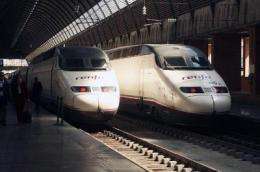How to act if there is a fire on the AVE

Researchers at the University of Cantabria have used computer models to analyse the best way to evacuate the Spanish High Speed Train, AVE, in the case of fire. The involvement of the crew in organising the fast transfer of passengers, completing the process before the train comes to a halt and collective collaboration to assist those with reduced mobility are just some of the strategies to be followed.
"In the event of fire on an AVE, two stages should be defined: the first is pre-evacuation in which passengers are transferred from one coach to another while the train is still in motion and the second involves evacuation once the train has stopped," as explained to SINC by Daniel Alvear, member of GIDAI Fire Safety Group of the University of Cantabria.
The team of researchers have analysed the best evacuation strategies on a high speed train, which has more inertia and less stops than others, using modelling tools and computer simulation. As Alvear says, "in this way it is possible to overcome drill exercise limitations which are costly, unrealistic and have a limited number of possible scenarios."
Even so, input data supplied to the computer come from a real drill carried out in 2009 by 218 people inside the Guadarrama tunnel between Madrid and Segovia. The study enjoyed the participation of the Spanish Railway Network, RENFE and has been published in the 'Fire Safety Journal'.
The results show that the pre-evacuation stage is "crucial" and the best strategy is to gather all passengers together before the train comes to a halt. Using a type of software, it was possible to determine the optimum and maximum number of coaches that can be evacuated from this type of AVE along with the time required to do so.
Two key aspects were identified in this process. One is to avoid those at the front of the evacuation line from impeding the movement of those behind. The solution involves one member of the crew hurrying up those at the front while another tells the others not to stop for their belongings. As a result, the aisle is not obstructed.
The second aspect refers to the need to evacuate those with reduced mobility. This is complex due to the AVE's narrow aisles that make the passage of wheelchairs difficult and the fact that the amount of crew is limited. Therefore, the involvement of all passengers is recommended to assist disabled people.
A question of minutes
Once the train has come to a halt, evacuation of the passengers can begin, taking into account the number of exits. If evacuation takes place onto the platform of the nearest station, exit availability will depend on the pre-evacuation strategy used.
For example, if the train is estimated to stop in less than 10 minutes, the results indicate that the coach on fire should ideally be evacuated along with both adjacent coaches either side.
When stopping time is calculated at more than 10 minutes, it is recommended that the maximum possible number of coaches is evacuated during pre-evacuation. This increases evacuation time by 27% compared to the first method, but passengers leave the train in safer conditions.
The driver and the railway traffic control centre are the ones who estimate how long it will take for the AVE to reach the nearest safe area, like a platform. The international standards stipulate that the train should arrive at a safe area some 15 minutes after the fire is detected.
In many cases this is difficult and the train has to quickly stop in the middle of the line to avoid further damages. The researchers have also considered the possibility of analysing what would happen if passengers had to alight directly onto the track ballast (the layer of gravel on which lays the track) using the emergency stairs.
The data show evacuation should be controlled by stages, giving priority to those individuals closest to the fire. This allows for quick, congestion free movement for those closest to the fire and minimises their exposure to the harmful effects of the flames.
More information: J.A. Capote, D. Alvear, O. Abreu, A. Cuesta. "Analysis of evacuation procedures in high speed trains fires". Fire Safety Journal 49: 35, 2012. Doi:10.1016/j.firesaf.2011.12.008


















